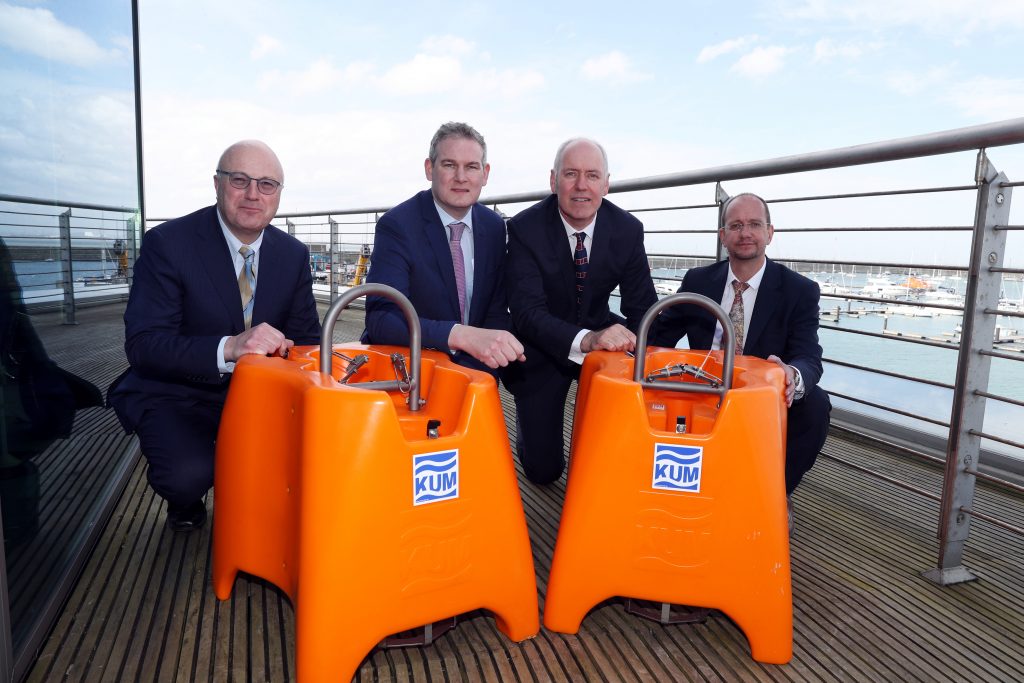Led by scientists from Dublin Institute for Advanced Studies (DIAS), the iMarl project is centred around state-of-the-art ocean bottom seismometers, which will be located deep in the Atlantic Ocean off the coast of Ireland. The seismometers will have a variety of uses, including detecting earthquakes and major weather events, tracking the presence of whales and dolphins, and capturing seabed images.

Pictured at the launch of the iMarl project – one of the most ambitious deep-ocean research project ever undertaken in Europe today (18.04.18) were: Professor Mark Ferguson, Director General of Science Foundation Ireland and Chief Scientific Adviser to the Government of Ireland; Minister of State for Rural Affairs and Natural Resources, Seán Kyne TD, Professor Chris Bean, Senior Professor of Geophysics and Director of the DIAS School of Cosmic Physics and Mr. Koen Verbruggen, Director of Geological Survey Ireland. (Picture Jason Clarke).
For further information, contact: Niamh Breathnach / Martina Quinn, Alice PR & Events. Tel: 01-5582151 / 085-1461231 / 087-6522033, email: media@alicepr.com
About DIAS
DIAS was founded by Éamon de Valera in 1940 as a centre of excellence for advanced scholarship focused on three disciplines: Celtic Studies, Theoretical Physics and Cosmic Physics. As a globally embedded institution which attracts scholars and academics from around the world, it conducts and publishes advanced research. The organisation also leads Ireland’s participation in a number of international research endeavours, runs the Dunsink Observatory and coordinates a range of national initiatives on behalf of government. Further information is available at www.dias.ie.
Wednesday 18th April 2018 – DIAS scientists launch major Atlantic Ocean research project
Leave a Comment
Last Updated: 3rd September 2018 by mary
Led by scientists from Dublin Institute for Advanced Studies (DIAS), the iMarl project is centred around state-of-the-art ocean bottom seismometers, which will be located deep in the Atlantic Ocean off the coast of Ireland. The seismometers will have a variety of uses, including detecting earthquakes and major weather events, tracking the presence of whales and dolphins, and capturing seabed images.
Pictured at the launch of the iMarl project – one of the most ambitious deep-ocean research project ever undertaken in Europe today (18.04.18) were: Professor Mark Ferguson, Director General of Science Foundation Ireland and Chief Scientific Adviser to the Government of Ireland; Minister of State for Rural Affairs and Natural Resources, Seán Kyne TD, Professor Chris Bean, Senior Professor of Geophysics and Director of the DIAS School of Cosmic Physics and Mr. Koen Verbruggen, Director of Geological Survey Ireland. (Picture Jason Clarke).
For further information, contact: Niamh Breathnach / Martina Quinn, Alice PR & Events. Tel: 01-5582151 / 085-1461231 / 087-6522033, email: media@alicepr.com
About DIAS
DIAS was founded by Éamon de Valera in 1940 as a centre of excellence for advanced scholarship focused on three disciplines: Celtic Studies, Theoretical Physics and Cosmic Physics. As a globally embedded institution which attracts scholars and academics from around the world, it conducts and publishes advanced research. The organisation also leads Ireland’s participation in a number of international research endeavours, runs the Dunsink Observatory and coordinates a range of national initiatives on behalf of government. Further information is available at www.dias.ie.
Category: Geophysics Section News & Events, News
Recent Posts
DIAS Astrophotography competition goes mobile for 2024
Irish scientists are part of groundbreaking discovery with James Webb Space Telescope
Dr Pauline Gagnon (formerly of CERN) to deliver two talks at DIAS
DIAS Professor announced as next President of the European Southern Observatory’s Council
Quake Shake: New programme encourages people to get involved in monitoring earthquakes
Language switcher